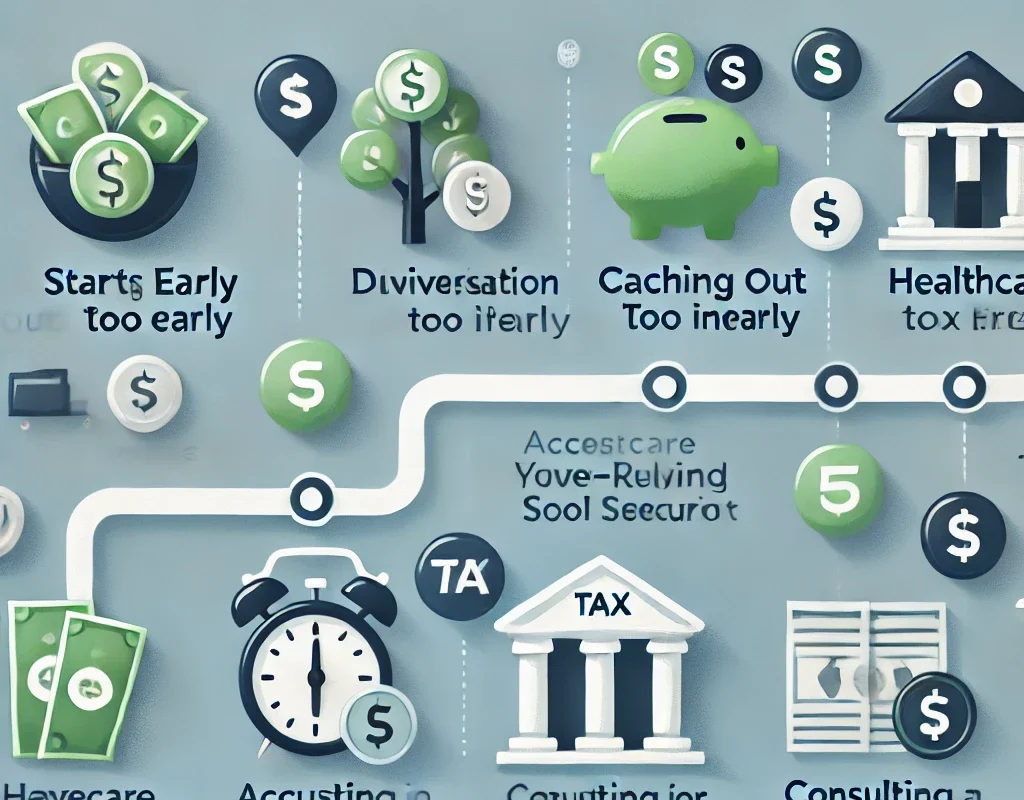Retirement is a significant milestone, yet many individuals fall prey to common mistakes that can derail their financial future. A well-thought-out plan ensures not only comfort and security but also peace of mind. Here’s how to avoid the most prevalent retirement planning mistakes and ensure your golden years are truly golden.
Understanding the Importance of Retirement Planning
Retirement planning is more than just saving money. It’s about envisioning your post-work life and preparing for various expenses, lifestyle choices, and unforeseen circumstances. With the average life expectancy rising, your retirement savings need to stretch further than ever before. Without careful planning, many retirees find themselves either outliving their savings or significantly lowering their standard of living.
Mistake: Delaying Retirement Savings
One of the most damaging mistakes individuals make is delaying their retirement savings. Time is your greatest ally when it comes to growing wealth due to the power of compound interest. The earlier you start saving, the more time your money has to grow. Waiting until your 40s or 50s to begin saving may seem manageable, but it dramatically reduces the time for compound interest to work its magic. Even small contributions in your 20s can yield impressive results decades later.
Why Start Early is Key
Starting early not only gives your money more time to grow, but it also spreads the burden of saving over many years. This approach means you can contribute smaller amounts while still reaching your financial goals. Consider this: an individual who starts saving $200 a month at age 25 and earns a 7% annual return will accumulate more than someone who starts at 40 and saves twice as much. The key is allowing your investments to snowball over time.
Mistake: Not Having a Clear Financial Goal
Without clear financial goals, it’s easy to veer off course. Some people save without really knowing what they are saving for or how much they’ll need. Others may vastly underestimate their retirement needs and come up short. A lack of goal-setting leaves you guessing, which can jeopardize your financial security later in life.
Setting SMART Financial Goals for Retirement
To create a clear path to retirement, setting SMART (Specific, Measurable, Achievable, Relevant, Time-bound) goals is crucial. These goals help you stay focused and give you a solid roadmap to follow. For example, instead of vaguely stating, “I want to save for retirement,” say, “I want to have $1 million saved by the time I’m 65.” This clear, specific target keeps your financial habits aligned with your retirement aspirations.
Mistake: Ignoring Inflation’s Impact
Inflation is an invisible force that erodes the purchasing power of your savings. Many retirees overlook this and assume that the amount they save today will hold the same value in the future. However, inflation can significantly impact your nest egg over time. For example, an annual inflation rate of 3% can cut your purchasing power in half over 25 years.
How to Plan for Inflation
To combat inflation, it’s essential to choose investments that outpace it. Stocks and real estate, for instance, tend to offer returns that can exceed inflation rates over the long run. Additionally, when projecting retirement expenses, it’s wise to factor in a higher future cost for goods and services. Consider investment vehicles like Treasury Inflation-Protected Securities (TIPS) that are designed to keep up with inflation.
Mistake: Relying Solely on Social Security
Many individuals assume that Social Security will be enough to sustain them in retirement. However, Social Security was never intended to be a retiree’s sole source of income. Instead, it’s designed to replace about 40% of the average worker’s pre-retirement income, leaving a significant gap that needs to be filled by personal savings and investments.
Social Security’s Role in Retirement
Social Security should be viewed as a supplemental income source rather than the foundation of your retirement plan. To bridge the income gap, it’s crucial to build a substantial nest egg through employer-sponsored retirement plans (like a 401(k)) or individual retirement accounts (IRAs). By doing so, you ensure that Social Security benefits are just a part of a diversified income stream.
Mistake: Underestimating Healthcare Costs
Healthcare costs are one of the most significant and often overlooked expenses during retirement. With advancing age comes an increasing likelihood of requiring medical attention, and without adequate planning, healthcare can take a considerable bite out of your retirement savings. Medicare helps, but it doesn’t cover everything, especially long-term care, dental, vision, or hearing services.
Addressing Healthcare Costs in Retirement
To avoid being blindsided by healthcare costs, it’s essential to budget for Medicare premiums, co-pays, and out-of-pocket expenses. Many retirees also opt for supplemental insurance plans (Medigap) or long-term care insurance to protect against catastrophic health-related expenses. Being proactive in this area ensures that your healthcare needs don’t derail your retirement budget.
Mistake: Not Diversifying Investments
Relying on a single asset class, such as stocks or bonds, exposes you to higher risk and volatility. Some individuals invest heavily in company stock or a particular sector, assuming it will continue to perform well indefinitely. This is a gamble that can lead to significant losses, especially if the market takes a downturn.
You Can Also Read : How to Balance Saving for Retirement and Paying Off Debt
Importance of Diversification in Retirement Planning
Diversification spreads risk across different asset classes—such as stocks, bonds, real estate, and cash—allowing for more stability in your portfolio. A well-diversified portfolio is better equipped to handle market volatility and provides multiple sources of returns. This balance reduces risk while still providing opportunities for growth, ensuring a more secure financial future in retirement.



